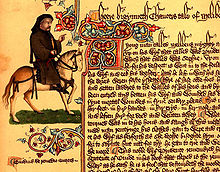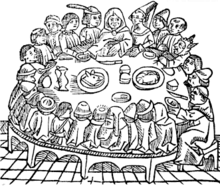Canterbury Tales
The Canterbury Tales or the Canterbury Tales ( Middle English Tales of Caunterbury ) are tales from the 14th century , by Geoffrey Chaucer were written from about 1387 to. Two of them are in prose , the rest in verse .
The stories, not all of which are considered original, are tied into a framework story about a group of pilgrims on their way from Southwark , a suburb of London , to Canterbury , where they want to visit the tomb of Thomas Becket in Canterbury Cathedral . The landlord Harry of the Tabard Inn suggests that the thirty pilgrims tell two stories on the way there and back and promises the best narrator a free meal as a prize.
The themes of the stories vary and deal with courtly love, betrayal and greed. The genres also vary, there are romances , Breton Lai (short rhythmic tales), sermons and fables . The characters introduced in the prologue tell stories of the highest cultural relevance.
The stories in detail

The stories are structured as follows, according to the Ellesmere order:
I. Fragment group A
- The General Prologue to the Canterbury Tales ' The General Prologue to the Canterbury Tales '
- The Knight's Tale 'The Tale of the Knight'
- The Miller's Prologue and Tale ' The Miller's Prologue and Tale '
- The Reeve's Prologue and Tale 'Prologue and Tale of the Governor'
- The Cook's Prologue and Tale 'Prologue and Tale of the Cook'
II. Fragment group B 1
- The Man of Law's Introduction, Prologue and Tale 'Introduction, Prologue and Tale of the Lawyer'
III. Fragment group D
- The Wife of Bath's Prologue and Tale 'Prologue and Tale of the Woman from Bath '
- The Friar's Prologue and Tale 'Prologue and Tale of the Friar '
- The Summoner's Prologue and Tale 'Prologue and Tale of the Church Shackle'
4. Group E fragment
- The Clerk's Prologue and Tale 'Prologue and Tale of the Scholar'
- The Merchant's Prologue and Tale 'Prologue and Tale of the Merchant'
5. Group F fragment
- The Squire's Introduction and Tale 'Introduction and Tale of the Squire'
- The Franklin's Prologue and Tale 'Prologue and Tale of the Landlord'
6. Fragment group C
- The Physician's Tale 'The Doctor 's Tale '
- The Pardoner's Introduction, Prologue and Tale 'Introduction, Prologue and Tale of the Indulgence Merchant'
7. Fragment group B 2
- The Shipman's Tale and Epilogue 'Tale and Epilogue of the Shipowner'
- The Prioress's Prologue and Tale 'Prologue and Tale of the Prioress'
- The Prologue, Tale and Epilogue of Sir Topas 'Prologue, Tale and Epilogue on Sir Topas'
- The Tale of Melibee ' The Tale of Melibeus'
- The Monk's Prologue and Tale 'Prologue and Tale of the Monk'
- The Nun's Priest's Prologue, Tale and Epilogue 'Prologue, Narration and Epilogue of the Nun Priest'
8. Group G fragment
- The Second Nun's Prologue and Tale 'Prologue and Tale of the Second Nun'
- The Canon's Yeoman's Prologue and Tale 'Prologue and tale of the canons' servant'
9. Group H fragment
- The Manciple's Prologue and Tale 'Prologue and Tale of the Steward '
10. Group I fragment
- The Parson's Prologue and Tale 'Prologue and Tale of the Pastor'
- Chaucer's Retraction 'Chaucer's Revocation'
Some of these narratives are humorous, some are serious, but all are very precise in describing human nature. Abuse of religion is a major issue. Another important element of the narratives is their focus on the three-part class structure : nobility , clergy , peasants . The work is not complete, 120 stories were originally intended, four for each participant, but only 21 were finished when Chaucer died.
Probably the greatest contribution of this work to English literature is the use of the vernacular instead of French ( Anglo- Norman ) or Latin , which were commonly used for literary work. The structure of the Canterbury Tales can be found in other contemporary works, such as Boccaccio's Decameron , which is considered one of Chaucer's main sources.
The history of printing and art was written by the edition of the graphic artist and pioneer of Art Nouveau , William Morris , which was published in his Kelmscott Press , founded in 1891 . After the mass products of the 19th century, there were again handcrafted and richly illustrated bibliophile works.
filming
- 1972: Pasolini's maddened stories (I racconti di Canterbury) . Director: Pier Paolo Pasolini
Editions of works (selection)
- The Canterbury Tales. London 1526.
- The Riverside Chaucer . Published by Larry D. Benson. Oxford Univ. Press, Oxford 1988, ISBN 0-19-282109-1 .
- Canterbury Tales. With an introduction, notes and a glossary by John Matthews Manly, London / Calcutta / Sydney [1928].
- The Hengwrt Chaucer digital facsimile . Edited by Estelle Stubbs. Scholarly Digital Editions, Leicester 2000, ISBN 0-9539610-0-1 .
- Caxton's Canterbury Tales: The British Library Copies on CD-ROM . Published by Barbara Bordalejo. Scholarly Digital Editions, Leicester 2003, ISBN 1-904628-02-8 or ISBN 1-904628-03-6 (different licensing). 4
- Geoffrey Chaucer: The Canterbury Tales . Translated by Adolf von Düring. Anaconda Verlag , Cologne 2008, ISBN 978-3-86647-217-4 .
literature
- Uwe Böker : Studies on Chaucer's Franklin's Tale. Inaugural dissertation, Regensburg 1968.
- Frederick Biggs: Chaucer's Decameron and the origin of the Canterbury tales . DS Brewer, Cambridge 2017, ISBN 978-1-84384-475-4 (English).
Web links
- The Canterbury Tales, and Other Poems by Geoffrey Chaucer - Projekt Gutenberg
- Geoffrey Chaucer Canterbury Tales (Canterbury Tales) - German translation by Adolf von Düring (1886) on Zeno.org
- Illustrated summary of contents in German
Individual evidence
- ↑ Kindlers Neues Literatur-Lexikon , Vol. 3, Chaucer: The Canterbury Tales , p. 910, Kindler, Munich 1998, ISBN 3-89836-214-0
- ↑ Geoffrey Chaucer: The Canterbury Tales (translated by Nevill Coghill), Penguin Classics 2003, ISBN 0-14-042438-5 (English).
- ↑ See on this Huling E. Ussery: Chaucer's Physician. Medicine and literature in Fourteenth Century England. New Orleans 1971.
- ^ Main thesis of the book by Frederick Biggs: Chaucer's Decameron and the origin of the Canterbury tales. Cambridge 2017.

